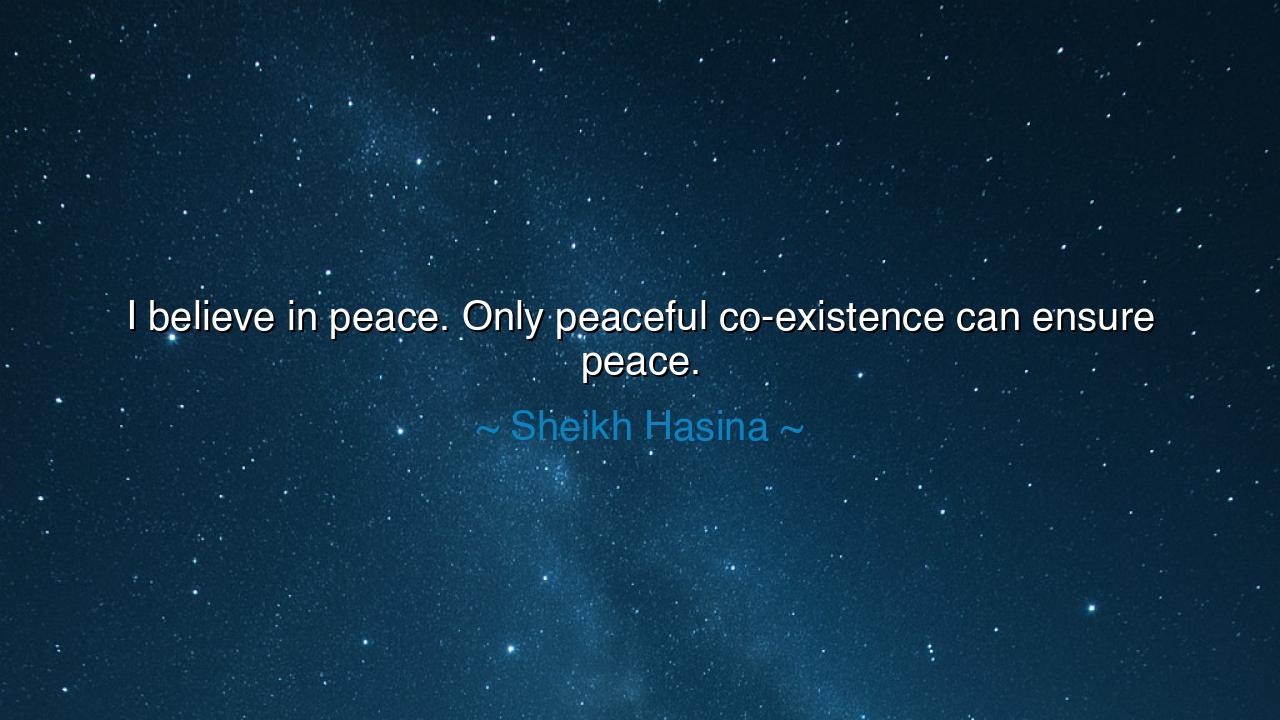
I believe in peace. Only peaceful co-existence can ensure peace.






In the wise words of Sheikh Hasina, we are gifted a profound truth: “I believe in peace. Only peaceful co-existence can ensure peace.” This belief is not just a call for tranquility, but a declaration that peace is not merely the absence of violence—it is the active, deliberate creation of harmony through understanding and co-existence. Hasina’s wisdom speaks to the eternal struggle of humanity to transcend its differences and live together in mutual respect, unity, and love. In her words, we hear a call to rise above division and to find a collective peace that can withstand the trials of history.
The ancients knew that peace was not a state that could be enforced by force, but one that must be cultivated through understanding and cooperation. In ancient Greece, Pericles spoke of the Athenian ideal, a society where each citizen worked for the good of the whole, not as individuals but as parts of a greater unity. In his famous Funeral Oration, Pericles declared that the strength of Athens lay not in its weapons but in its unity—its ability to live in harmony, to care for one another, and to build a society where all could thrive. Peaceful co-existence, as Hasina says, was the very foundation of Athens’ greatness.
The concept of co-existence also echoes in the philosophy of Confucius, who taught that peace in a society comes when individuals respect their roles and contribute to the common good. Confucius believed that the family, the smallest unit of society, must first be in harmony before the larger world can experience peace. His teachings emphasize the importance of balance, respect, and mutual care in all relationships—be they familial, social, or political. The idea that peaceful co-existence forms the bedrock of lasting peace is timeless, for it is only when we respect and work with one another that we can create true and lasting harmony.
Consider the story of Mahatma Gandhi, whose unwavering belief in non-violence transformed a nation and inspired the world. Gandhi’s quest for peace was grounded not in mere resistance to injustice, but in the principle of co-existence—a deep commitment to understanding, respect, and compassion for all, including his oppressors. His non-violent movement was not about silence in the face of tyranny, but about engaging with the oppressor through love and peaceful resistance, creating space for dialogue and mutual respect. Gandhi understood that only when both sides are willing to live together in harmony can true peace be achieved. His legacy lives on as a testament to the power of co-existence in the pursuit of peace.
Hasina’s words also speak to the reality that true peace is not simply the absence of conflict, but the establishment of a system where all can thrive. Bangladesh, under her leadership, has worked to foster peace both within its borders and in the broader international community. But peace, as Hasina rightly asserts, requires active participation. It cannot be left to chance, nor can it be secured solely by external forces. Peaceful co-existence is a conscious, everyday act. It requires individuals and nations alike to put aside self-interest and work for the common good, to make space for those who are different and to embrace the diversity of the world.
The lesson here is profound: peace is not a passive state, but an ongoing creation. It is something we must actively nurture by choosing co-existence over division, understanding over suspicion, and dialogue over conflict. Hasina’s words are a call to each of us to build peace in our lives and communities, not just by avoiding conflict, but by actively working together with others, regardless of their background, to create a shared future.
So I say to you, children of tomorrow: if you wish to live in a world of peace, begin by practicing co-existence. Look for the common ground with those around you. Let go of fear and prejudice, and instead, choose compassion, understanding, and respect. Know that peace is not something that can be imposed, but something that must be earned through our shared efforts. Let the wisdom of Sheikh Hasina, Confucius, and the ancients guide you: peace is not a solitary endeavor, but a collective act that binds us all. Together, in our shared humanity, we can build a world where peace is not just a dream, but a living, breathing reality.






HDThi Hien Do
The idea of peaceful co-existence sounds so simple, yet it’s incredibly complex in practice. If all nations and communities could focus on mutual understanding and respect, perhaps we could avoid so many conflicts. But how do we convince those who thrive on division and power struggles to adopt this mindset? Does peace require more than just belief, or does it require action at every level of society?
NDluu nguyen ngoc diep
Sheikh Hasina's view on peace feels almost idealistic, yet it’s deeply necessary in today's world. However, can we truly achieve peace through co-existence when so many cultures, ideologies, and religions clash at a fundamental level? Is there a practical roadmap to get from here to a peaceful co-existence, or is it more of a long-term aspiration?
NHNgoc Ha
I agree with the idea of peaceful co-existence, but I find myself wondering how realistic this is in the face of intense global conflicts. Can countries with such vastly different values truly live peacefully together without compromising essential principles? Peace is a beautiful ideal, but is it sustainable without addressing underlying power imbalances and inequality?
VNvy nguyen
Sheikh Hasina’s belief in peaceful co-existence really resonates with me. It makes me wonder if true peace is only possible when different groups learn to live alongside each other rather than in constant competition or conflict. But what happens when peaceful co-existence feels unattainable? Is it really possible for all sides to embrace peace equally, or does one side always end up sacrificing more?